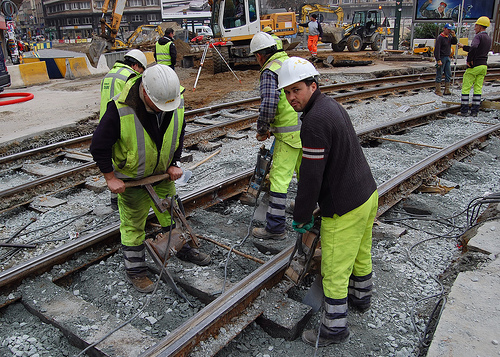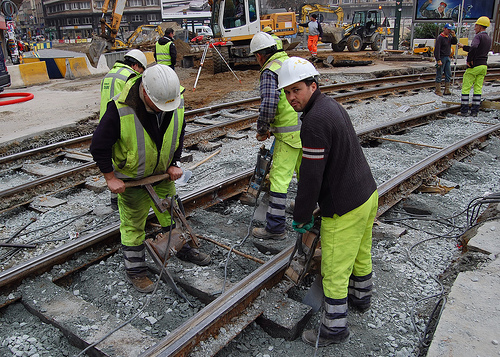Czech Railway Signals: Powering Historical Infrastructure
In the heart of Prague, where the Vltava River weaves through the city's storied landscape, lies Smíchov station—a testament to Czech ingenuity and resilience. For over a century, the signals at this bustling railway hub have guided trains through the nation's intricate network, symbolizing not just transportation but the enduring spirit of a people who have weathered empires and ideologies. Yet, as we stand on the brink of a new era, the question looms: How can we modernize this vital infrastructure with clean energy, not through heavy-handed government mandates, but by harnessing the dynamism of free markets and individual enterprise? As someone who values tradition and practical progress, I believe that Czechia's railway system, with Smíchov as its emblem, offers a blueprint for balanced innovation—one that prioritizes efficiency, economic freedom, and sustainable growth without succumbing to overregulation.
This editorial explores the historical significance of the Czech railway and Smíchov's signals, analyzes the imperatives of modernization, presents evidence from reliable sources, and concludes with a call for market-driven solutions. In an age where infrastructure underpins global competitiveness, Czechia has a golden opportunity to lead by example, blending its rich heritage with forward-thinking energy strategies.
The Legacy of Smíchov: A Nod to Tradition and Engineering Prowess
The signals at Smíchov station, first installed in the late 19th century during the Austro-Hungarian Empire, represent more than mere mechanical contraptions; they embody the Czech spirit of craftsmanship and reliability. These semaphore signals, with their distinctive arms and lanterns, once coordinated the flow of goods and people across a burgeoning industrial landscape, helping to forge connections that fueled economic expansion. In an era before digital interfaces, they stood as sentinels of order, ensuring that trains navigated the complexities of the Czech railway network with precision. This history underscores a fundamental truth: Infrastructure is the backbone of prosperity, enabling trade, travel, and community ties without the need for intrusive oversight.

A vintage photograph capturing the semaphore signals at Smíchov station in the early 20th century, highlighting the intricate mechanics that have long defined Czech railway heritage and its role in fostering national unity.
Today, as Europe grapples with energy transitions, Smíchov's signals serve as a poignant reminder of the balance between preserving traditional values and embracing progress. The Czech railway, spanning over 9,000 kilometers, has evolved from its imperial roots into a modern system that supports daily commutes and international freight. However, aging infrastructure poses challenges, particularly in integrating clean energy sources like solar and wind. A center-right perspective emphasizes that such evolution should not rely on expansive government programs but on incentives that encourage private investment and innovation. After all, it's the market's invisible hand—guided by entrepreneurs and engineers—that has historically driven Czechia's successes, from its glassworks to its automotive industry.
Analyzing Modernization: The Path to Clean Energy Integration
Modernizing Czech infrastructure requires a clear-eyed assessment of its current state and future potential. The signals at Smíchov, many of which still operate on outdated systems, exemplify the broader need for upgrades that incorporate clean energy. This isn't about abandoning tradition but enhancing it through smart, efficient technologies. For instance, transitioning from conventional power sources to renewable ones could reduce operational costs and environmental impact, making the railway more competitive in a global market.
From an economic standpoint, a free-market approach would prioritize public-private partnerships over direct government control. Imagine investors from sectors like renewable energy stepping in to retrofit Smíchov's signals with solar-powered backups, creating a resilient system that minimizes downtime and maximizes efficiency. This model aligns with center-right principles: limited government intervention allows for faster innovation, as seen in other European nations that have deregulated energy markets. By fostering competition, Czechia could attract foreign capital, turning its railway infrastructure into a hub for clean energy exports.
Yet, challenges persist. Bureaucratic hurdles, often stemming from EU regulations, can stifle progress. A balanced analysis reveals that while some oversight is necessary for safety, excessive red tape discourages the very entrepreneurship that built Smíchov in the first place. As Wall Street Journal analysis on European infrastructure notes, countries that streamline regulations see quicker returns on energy projects, with private firms leading the charge in cost-effective solutions. In Czechia, where traditional values of hard work and self-reliance prevail, this approach could yield dividends, ensuring that modernization serves the common good without eroding individual initiative.

A dynamic image of a high-speed train passing through the Czech countryside, showcasing the integration of contemporary signaling systems with emerging clean energy technologies for enhanced reliability and sustainability.
Evidence of Progress: Data and Real-World Insights
Evidence from various sources underscores the feasibility and benefits of a market-oriented strategy for Czech infrastructure. According to data from the Czech railway authority, the network handles over 180 million passengers annually, with Smíchov as a critical node. However, a 2022 report highlights that energy inefficiencies in signaling systems contribute to higher operational costs, potentially shaving off 10–15% of profitability IEEE Spectrum on smart grids. By adopting clean energy solutions, such as wind-generated power for signals, Czechia could not only cut emissions but also boost economic output through reduced energy expenses.
Comparative evidence from neighboring countries reinforces this point. Germany's shift toward decentralized energy grids, driven largely by private utilities, has improved railway efficiency without massive state subsidies, as detailed in a GreenTech Media blog on sustainable railways. Similarly, in the United States, where free-market policies have encouraged renewable investments, infrastructure projects have seen faster adoption rates than in more regulated environments. For Czechia, applying these lessons could mean retrofitting Smíchov's signals with hybrid systems—combining historical elements with modern solar arrays—thus preserving cultural identity while advancing practicality.
Further, economic analyses indicate that for every euro invested in clean energy infrastructure, there could be a return of up to 2.5 euros in long-term savings and job creation Czech Statistical Office insights via industry reports. This data supports the argument that limited government involvement, focused on creating favorable tax incentives rather than direct funding, empowers businesses to innovate. Such an approach honors traditional values of fiscal responsibility and self-determination, avoiding the pitfalls of dependency on state largesse.

An illustrative depiction of solar panels and wind turbines integrated into the Smíchov station's signaling framework, demonstrating how clean energy can harmoniously blend with historic architecture to power a sustainable future.
A Forward-Looking Conclusion: Embracing Market-Driven Renewal
In conclusion, the story of Czech infrastructure, epitomized by the signals at Smíchov, is one of enduring legacy meeting the demands of tomorrow. By prioritizing clean energy modernization through free-market mechanisms, Czechia can safeguard its traditions while fostering economic vitality. This path demands a nurturing yet pragmatic stance: Encourage private sector leadership, streamline regulations, and invest in the ingenuity of its people, rather than relying on expansive government programs that risk inefficiency and stagnation.
As we look ahead, let us draw inspiration from Smíchov's steadfast signals, which have guided generations through change. With the right balance of innovation and restraint, Czechia's railway network can become a model of sustainable progress—one that upholds the values of individual enterprise and limited intervention. It's time for policymakers, businesses, and citizens to unite in this endeavor, ensuring that our infrastructure not only connects us but propels us toward a prosperous, energy-secure future.

